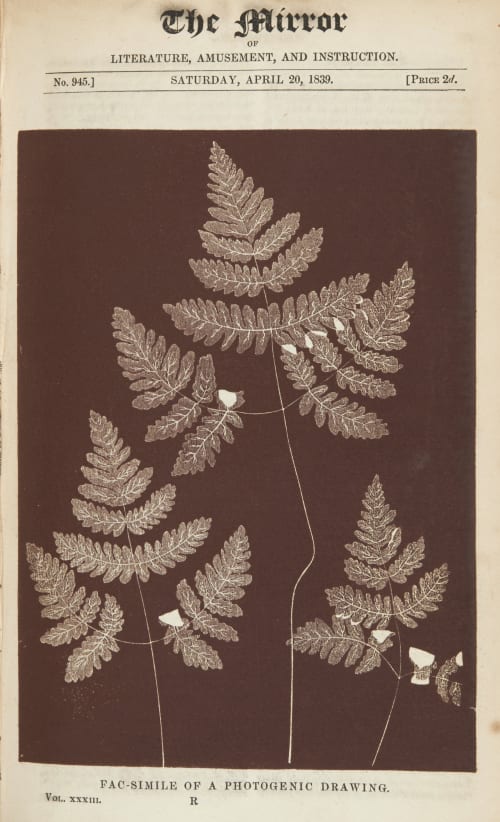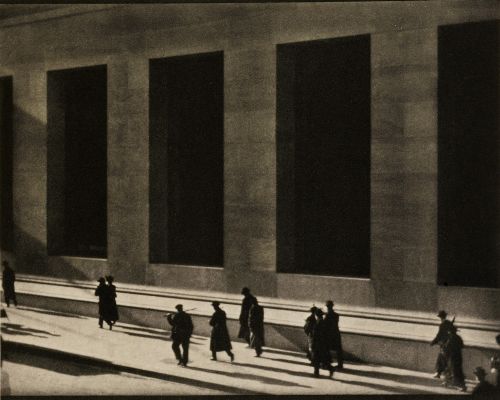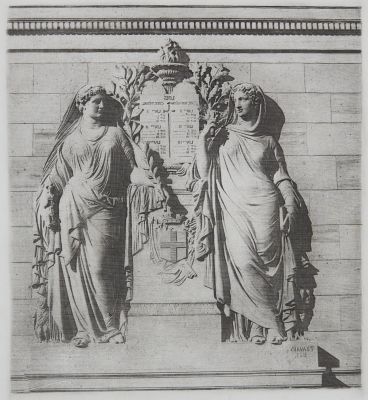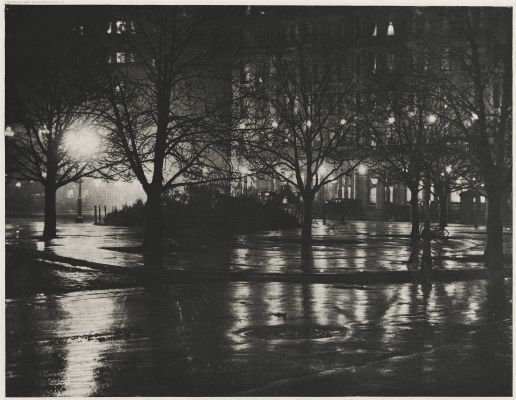
Title
Fac-simile of a Photogenic DrawingArtist
Bird, Dr. Golding (British, 1814-1854)Publication
The Mirror of Literature, Amusement and InstructionDate
1839Process
PhotoxylographAtelier
Bird, Dr. GoldingImage Size
15 x 11 cm
On April 20, 1839, this London magazine featured as its cover the first published reproduction of a photograph Facsimile of a Photogenic Drawing. It is a picture —in negative—of three stalks of leaves. The original was made by Golding Bird, "a distinguished botanist" by following William Henry Fox Talbot’s newly invented process, the details of which were made public at the Royal Society on February 21. The woodcut is much larger than usual for The Mirror, and was printed in a unique color that simulated the color of Talbot’s first calotypes. The method was explained To take a Photographic Copy on Boxwood. Place the smooth side of a block of boxwood in a shallow dish or plate, containing a solution of salt, twenty grains to an once of water. When it has remained in it for about five minutes, take it out and dry it, and then put the same side in another plate containing sixty grains of nitrate of silver, dissolved in an ounce of water. After the elapse of a minute, take it out, and dry it. It will then, on exposure to light, assume a fine brown colour. If it be again immersed in each solution, for a few seconds only, it will become so sensitive, as to be affected by a very slight degree of light. To obtain a drawing of a view, or a copy of a picture, &c. proceed with the prepared block, precisely according to the instructions already given for using the photographic paper. In this manner, a drawing upon a block may be most expeditiously obtained, and without the services of a draughtsman. It only needs the wood-engraver. [1]
Dr. Bird displayed his chemical prowess as a child, regularly lecturing and demonstrating on chemistry to his fellow schoolmates. He became an exceptional physician and invented the flexible stethoscope still familiar today. In 1836 Bird was appointed to the chair of natural philosophy at Guy’s Hospital, London. It was in a letter dated March 25, 1839, and published in the Magazine of Natural History, ‘Observations on the Application of Heliographic or Photogenic Drawing to Botanical Purposes,’ that Bird revealed his insight into the new art. A month later, in the Mirror, his text was illustrated by this icon of early photography, Bird had displayed interest in the action of light in the 1839 edition of his popular Elements of Natural Philosophy, written before the announcement of photography. In the second edition of 1844, he devoted an entire chapter to photography, expanding this in subsequent editions. Although he never exhibited and none of his own photographs are known to have survived, Puttick and Simpson’s 1856 auction of Bird’s library included not only photographic equipment but also many photographs “by artists of the first eminence,” including Roger Fenton, James D. Robertson, Pilip Henry Delamotte, and Hugh Owen.
Reproduced / Exhibited
Gernsheim, Helmut. Creative Photography. Aesthetic Trends 1839-1960. [with Illustrations.]. London: Faber & Faber, 1962. p. 291
Foster, Sheila J, Manfred Heiting, and Rachel Stuhlman. Imagining Paradise: The Richard and Ronay Menschel Library at George Eastman House, Rochester. Göttingen: Steidl, 2007 p. 162
Talbot, William H. F. Specimens and Marvels. New York: Aperture, 2000. p. 74
Stevenson, Sara, and John O’Neil. Printed Light: The Scientific Art of William Henry Fox Talbot and David Octavius Hill with Robert Adamson. Edinburgh: Scottish National portrait gallery, 1986. p. 14.
Schaaf, Larry J, and Talbot. Sun Pictures, ‘Talbot and Photogravure’. New York: Hans P. Kraus, Jr., Inc, 2003. no. 3.
Hanson, David A. Checklist of Photomechanical Processes and Printing, 1825-1910. , 2017. p. 105.
Impressed by Light, British Photographs from Paper Negatives by Roger Taylor, Yale University Press, New Haven, 2007, pg 291
Salts of Silver, Toned With Gold by Anne Anninger and Julie Melby, The Houghton Library, Harvard University, 1999, pg 12
Beaumont Newhall, On Photography, A Source Book of Photo History In Facsimile, Century House, Watkins Glen, 1956, pg 72
An Exhibition on Photographic Reproduction Processes from The Collection of Samuel J. Wagstaff, Jr. at the Grolier Club. 1983
References
[1] The Mirror of Literature, Amusement and Instruction pg. 317 May 18, 1839, no. 949
Golding Bird, “Observations on the Application of Heliographic or Photogenic Drawing to Botanical Purposes,” Magazine of Natural History, n.s., 3 (April 1839), pp. 188-92; “Fac-Simile of a Photogenic Drawing,” Mirror, April 20, 1839, p. 241 (with reprint of Bird’s article in Magazine of Natural History); Golding Bird, Elements of Natural Philosophy: Being an Experimental Introduction to the Study of the Physical Sciences, 2nd ed. (London: John Churchill, 1844) (and later editions); Frederic Bird, “The Late Dr. Golding Bird,” Association Medical Journal, January 5, 1855, pp. 1-6
[1] Taylor, Roger, and Larry J. Schaaf. Impressed by Light: British Photographs from Paper Negatives, 1840-1860 : P. 292 Accompanies the Exhibition ‘impressed by Light – British Photographs from Paper Negatives, 1840-1860’ Held at the Metropolitan Museum of Art, New York, September 24 – December 30, 2007 ; at the National Gallery of Art, Washington, D.c., February 3 – May 4, 2008 ; and at the Musée D’orsay, Paris, May 26 – September 7, 2008. New York: The Metropolitan Museum of Art, 2007. Print.











